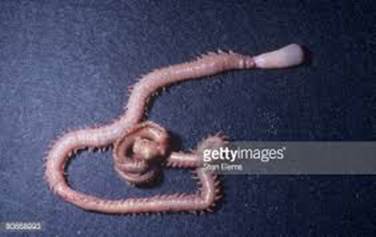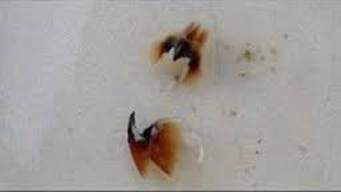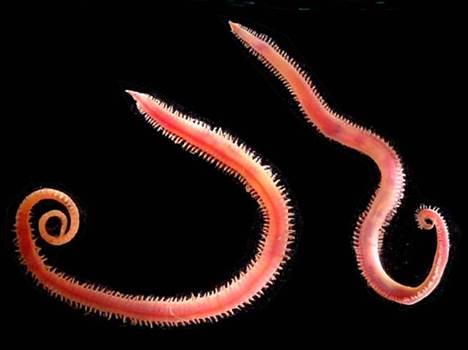Great attention gets paid to rainforests because of the diversity of life there. Diversity of the oceans is even greater. Sylvia Earle, Oceanographer
he genus Glycera is a group within the Class of Polychaetes that are commonly referred to as blood worms. They are found in marine sediments in shallow water. They have a creamy pink to red color with small antennae at the head and fleshy projections called parapodia running down the length of their bodies.
They can grow to about 14 inches long. They have a pair of pits lined with cilia (rows of fine hair) on their head known as nuchal organs that are thought to be chemorecptors and help them seek out food. Glycera – this is a Greek reference to courtesans – I’m not sure what the relationship is to the genus.
These worms are not good swimmers but burrow into the sand or silt bottoms of intertidal and subtidal areas. They are carnivorous and feed by extending a sizable proboscis that includes four hollow jaws. This is a modified pharynx that can be quickly inverted to grab prey. Be thankful that these fierce predators don’t grow to six feet long. They have toxin glands that secret poison with their bite that can be quite painful to a human – and surprising because of the speed that they extend their proboscis.
They will prey upon a variety of invertebrates and are in turn preyed upon by other works, bottom-feeding fish, seabirds and gulls, and crustaceans. They often are harvested as bait by recreational fishers and some folks make a living by digging blood worms and selling them for bait. Near the shore you can buy them at 7-11 in a plastic bag with some seaweed to keep them happy – temporarily anyway.


Water temperature and the lunar cycle will initiate reproduction, which occurs during mid-summer. Sexually mature worms will transform into a non-feeding stage called the epitoke. Their parapodia enlarge and they swim to the surface of the water where the male and females will release gametes – and then die. Fertilized eggs will float around with the plankton and will eventually metamorphose into an adult form after adding segments.
I would run into these as a kid down at the beach when fishing and saw folks using them as bait. We would catch them for amusement and put them in a bucket of water – there were quite fascinating and so far removed from the familiar earthworm we weren’t sure just what they were – but knew them as blood worms. Tapping their head lightly with a stick would make them shoot out their proboscis at an alarming speed that we would jump back from the bucket. https://www.youtube.com/watch?v=mktMxLrU8rA
I don’t think I ever quite got up the nerve of handling them for more than a second while tossing them in or out of bucket. Later in invertebrate zoology we had to dissect them and the internal structure of the proboscis, coiled back like a set spring, was quite interesting.
